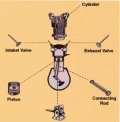
Parts of a reciprocating engine.

Four-stroke five-event cycle..
|
Internal Combustion or Reciprocating Engine
Another name for a reciprocating engine is an internal-combustion engine. It has this name because the fuel burns inside the engine. It is also often called a piston engine because it has pistons as one of its parts. The major parts of an internal combustion engine are (1) the cylinders, (2) the pistons, (3) the connecting rods, (4) the crankshaft, (5), intake and exhaust valves, (6), the spark plugs, and (7) a valve operating mechanism-also called a cam.
Reciprocating engines require fuel, air, compression, and a source of combustion to function.
In a modern airplane engine, air mixed with gasoline is drawn into a cylinder, then compressed by a piston moving up and down inside a chamber called a cylinder. A spark from a spark plug ignites the mixture of fuel and air. This causes an explosion that drives the piston downward, creating power. Then the exhaust valve opens and the burned-up gases are pushed past the valve into an exhaust pipe by the piston. Then the process starts over again. This happens hundreds of times a minute. This process is called a four-stroke operating cycle.
|



